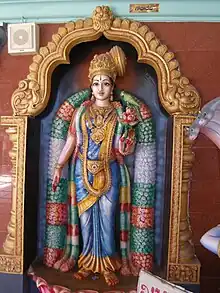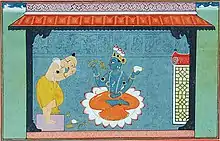| Nachiyar Tirumoli | |
|---|---|
 Statue of Andal, Tirumala. | |
| Information | |
| Religion | Hinduism |
| Author | Andal |
| Language | Tamil |
| Period | 9th–10th century CE |
| Verses | 143 |
| Part of a series on |
| Vaishnavism |
|---|
 |
The Nachiyar Tirumoli (Tamil: நாச்சியார் திருமொழி; transl. Sacred Verses of the woman/goddess[1])[2] is a set of 143 verses composed by Andal, one of the twelve Alvars in Sri Vaishnava tradition. In her restlessness and eagerness to attain Kannan (Krishna), Andal attempts various methods by which she can attain union with him, which forms the major part of work. Among the tirumolis, Varanam Ayiram is very well-known and has a special significance. It details Andal's narration of her dream of her experiences with her friends on her way to achieve her purpose of birth (to marry Kannapiran).
These 143 verses are a part of the 4000 divine hymns of Nalayira Divya Prabandham. The verses are classified into fourteen decads, namely, a prayer to Kama, not to destroy a sand castle, Vastapraharana, securing union with Krishna, requesting a cuckoo to call the deity, Andal's wedding, eulogising Vishnu's conch, Megha Sandesa, pangs of separation from Krishna, seeking help to attain Krishna, and in praise of Ranganatha.
Etymology
Tirumoli literally means "sacred verses" in a Tamil poetic style and nachiyar means "woman", sometimes also translated as goddess. Therefore, the title means "sacred verses of the woman or goddess". This poem fully reveals Andal's intense longing for Vishnu, her divine beloved. Utilising classical Tamil poetic conventions and interspersing stories from the Vedas and the Puranas, Andal creates imagery that is possibly unparalleled in the whole gamut of Indian religious literature.[3][4][5]
Organisation of the verses
| Topics in Tamil literature | ||
|---|---|---|
| Sangam Literature | ||
| Five Great Epics | ||
| Silappatikaram | Manimekalai | |
| Civaka Cintamani | Valayapathi | |
| Kundalakesi | ||
| The Five Minor Epics | ||
| Neelakesi | Culamani | |
| Naga Kumara Kaviyam | Udayana Kumara Kaviyam | |
| Yashodhara Kaviyam | ||
| Bhakti Literature | ||
| Naalayira Divya Prabandham | Kamba Ramayanam | |
| Tevaram | Tirumurai | |
| Tamil people | ||
| Sangam | Sangam landscape | |
| Tamil history from Sangam literature | Ancient Tamil music | |
These 143 pasurams (verses) are organized in 14 segments and each one is called tirumoli. Each tirumoli deals with one specific topic.[6] The first decad is a set of verses to pray to Kama to seek Krishna as her husband. Andal expresses that she will lose her life if she is married to someone else other than Krishna. The second decad is a compilation of Andal's prayer to preserver the sand castle she built on the river. The third decad is a set similar to the vastraprahana, the playful chapter in Krishna's life when he took away garments of the gopikas and their request to get them back. The fourth decad has poems where she expresses her union with Krishna. Kuyil Pattu or cuckoo's song forms the fifth decad where Andal requests cuckoo to sing in praise of Krishna. Experts attribute the verses to Pancharatra Agama, a mode of worship practiced in Vaishnavite temples. The sixth decad indicates her dream to marry the deity laying down the principles of spiritual dynamics. The eighth tirumoli called "Vinnila Melappu" deals with the poetess telling her plight to the clouds and sending them as her messenger to Govinda, who is present in Tirumala. The remaining tirumolis are dedicated to different efforts by Andal to somehow speed up her union with Perumal. In the process, she waits impatiently, and finally in Patti Meindor Karerur Tirumoli, she is reunited with Vishnu.[7]
Critical analysis
Some of Andal's verses express love for Vishnu, written with bold sensuality and startlingly savage longing, hunger and inquiry, that even today many of her most erotic poems are rarely rendered publicly.[8] In one such verse Andal dispenses with metaphor and imagines that she herself in lying in the arms of Krishna, and making love to him:[9]
"My life will be spared / Only if he will come / To stay for me for one night / If he will enter me, / So as to leave / the imprint of his saffron paste / upon my breasts / Mixing, churning, maddening me inside, / Gathering my swollen ripeness / Spilling nectar, / As my body and blood / Bursts into flower."
[10][11]
tell him I will survive
only if he will stay with me
for one day -
enter me
so as to wipe away
the saffron paste
adorning my breasts
(p. 140)[12]
Andal whilst admiring herself wearing the garland which was meant for the deity,
the guilt glazed love lay on Andal's breasts.
thick and heavy as him.
frightened with force
and locked away, she conjured him every night,
her empurumaan, her emperor-man.
My surging breasts long to leap to the touch of his hand which holds aloft the flaming discus and the conch.
Coax the world-measurer to caress my waist, to encircle the twin globes of my breasts
In one of her poems, Andal says that her voluptuous breasts will swell for the lord alone, and scorns the idea of making love to mortal beings, comparing that with the sacrificial offering made by Brahmins being violated by jackals in the forest,[18] and in another verse she dedicates her swelling breasts to Krishna who carries a conch.[11][19]
In popular culture
The hymns of the Nalayira Divya Prabandham are regularly sung in all the Vishnu temples of South India daily and also during festivals.[20][21] Andal is worshipped as a goddess in the Sri Vaishnava tradition of South India, and enshrined in several Vishnu temples. The verses of the Tiruppavai and Nachiyar Tirumoli are sung commonly in all the households and temples during the month of Margali (December - January).[22]
A redention of Varanam Ayiram was included in Ilaiyaraaja's score for Kamal Haasan's movie Hey Ram, with Shrivilliputhur Andal being acknowledged as one of the lyricists for the movie.[23][24]
See also
References
- ↑ Madras, University of (1924–1936). "Tamil lexicon". dsal.uchicago.edu. Retrieved 10 December 2022.
- ↑ "Andal-Nacciyar Tirumoli – Poetry Makes Worlds". Retrieved 1 August 2022.
- ↑ Rao, Shivshankar (31 March 2013). "Saints - Andal". Sushmajee: Dictionary Of Hindu Religion. US Brahman Group. Retrieved 11 August 2015.
- ↑ Andal (14 October 2000). Andal: Tiruppavai/Nachiyar Tirumozhi. Penguin Books Australia. ISBN 0140245723.
- ↑ "Nachiyar aesthetically conceived". The Hindu. 5 January 2001. Retrieved 11 August 2015.
- ↑ Sadagopan (2008). Nachiyar Thirumozhi (PDF). Retrieved 15 April 2018.
- ↑ Vankeepuram|2005, pp. 9-12
- ↑ Rajarajan, R K K (2015). "Art and Literature: Inseparable Links". The Quarterly Journal of the Mythic Society. 106 (4): 53–61. Retrieved 28 April 2017.
- ↑ Lakshmi, C S (7 December 2003). "Landscapes of the body". The Hindu. Retrieved 25 January 2018.
- ↑ Dalrymple, William (10 July 2015). "In search of Tamil Nadu's poet-preachers". No. London. Financial Times. The Financial Times Limited. Retrieved 13 July 2015.
- 1 2 Chakravarty, Uma (1989). "The World of the Bhaktin in South Indian Traditions - The Body and Beyond" (PDF). Manushi. 50-51-52: 25. Retrieved 18 September 2015.
- ↑ Dehejia, Vidya (2008). The Body Adorned: Sacred and Profane in Indian Art. New York: Columbia University Press. p. 141. ISBN 9780231512664. Retrieved 25 January 2018.
andal breasts.
- ↑ Kandasamy, Meena (2010). Ms Militancy. Narayana. ISBN 9788189059347.
- ↑ Mulchandani, Sandhya (2014). "Divine Love". The Indian Quarterly. Archived from the original on 17 November 2015. Retrieved 11 August 2015.
- ↑ Bilwakesh, Champa (16 March 2011). "Ms Militancy, by Meena Kandasamy". Archived from the original on 18 November 2015. Retrieved 11 August 2015.
- ↑ Chabria, Priya Sarukkai (2016). Chabria, Priya Sarukkai; Shankar, Ravi (eds.). Andal: The Autobiography of a Goddess. Zubaan Books. ISBN 9789384757670.
- ↑ Venkatesh, Arundhati (17 May 2016). "Andal: The Tamil Female Saint Brought To You In A Very Satisfying Translation [Book Review]". Women's Web. Retrieved 25 January 2018.
- ↑ Ghai, Anuj. "Reflections on Andal". Academia.edu. Retrieved 22 July 2015.
- ↑ Rajarajan, R.K.K. (January 2016). "Art and Literature: Inseparable Links". The Quarterly Journal of the Mythic Society.
- ↑ Dalal 2011, pp. 20-21
- ↑ Ramaswamy, Vijaya (2007). Historical Dictionary of the Tamils. Scarecrow Press. p. 211. ISBN 9780810864450.
- ↑ "Emotional Ecstasy and Those Mystic Muses". New Delhi: Mint. 1 February 2014. Archived from the original on 15 April 2018. Retrieved 15 April 2018 – via HighBeam Research.
- ↑ Rangan, Baradwaj (28 August 2015). "He taught me to sing with abandon". The Hindu. Retrieved 6 December 2018.
- ↑ "Hey! Ram (2000)". Turner Classic Movies. Retrieved 6 December 2018.
Sources
- Dalal, Roshen (2011). Hinduism: An Alphabetical Guide. Penguin Books India. ISBN 9780143414216.
- Vankeepuram, Rajagopalan (2005). Andal's Nachiyar Thirumozhi (Love Transcendental). V.K.N. Publishers. ISBN 81-902979-1-0.